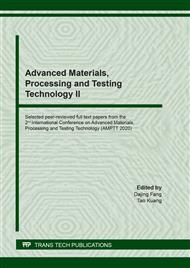[1]
J. P. Biersack, L. G. Haggmark, A Monte Carlo computer program for the transport of energetic ions in amorphous targets, Nucl. Instrum. Methods. 174 (1980) 257-269.
DOI: 10.1016/0029-554x(80)90440-1
Google Scholar
[2]
Robert Gérard, Frédéric Somville, Situation of the Baffle-Former Bolts in Belgian Units, In: Proceedings of the 17th International Conference on Nuclear Engineering ICONE17, Brussels, 2009, pp.1-8.
Google Scholar
[3]
C. Xu, L Zhang, W Qian, et al, The Studies of Irradiation Hardening of Stainless. Steel Reactor Internals under Proton and Xenon Irradiation, Nuclear Engineering and Technology, 48 (2016) 758-764.
DOI: 10.1016/j.net.2016.01.007
Google Scholar
[4]
R.D. Carter, D.L. Damcott, M. Atzmon, et al, Effects of proton irradiation on the microstructure and microchemistry of type 304L stainless steel, Journal of Nuclear Materials 205 (1993) 361-373.
DOI: 10.1016/0022-3115(93)90101-4
Google Scholar
[5]
G Gupta, Z Jiao, A N Ham, et al. Microstructural evolution of proton irradiated T91, Journal of Nuclear Materials 351 (2006) 162-173.
DOI: 10.1016/j.jnucmat.2006.02.028
Google Scholar
[6]
Gary S Was. Fundamentals of Radiation Materials Science First ed., Verlag, Berlin, (2007).
Google Scholar
[7]
T Terachi, T Yamada, T Miyamoto, et al, SCC growth behaviors of austenitic stainless steels in simulated PWR primary water, J. Nucl. Mater., 426 (2012) 59-70.
DOI: 10.1016/j.jnucmat.2012.03.013
Google Scholar
[8]
S J Zinke, G S Was, Materials challenges in nuclear energy, Acta mater., 61 (2013) 735-758.
Google Scholar
[9]
Kurt E. Sickafus, Eugene A. Kotomin, Blas P. Uberuaga. Radiation Effects in Solids, Sicily, Italy, (2004).
Google Scholar
[10]
Z Jiao, G S Was, Novel features of radiation-induced segregation and radiation-induced precipitation in austenitic stainless steels, Acta Materialia 59 (2011) 1220–1238.
DOI: 10.1016/j.actamat.2010.10.055
Google Scholar
[11]
S.M Bruemmer, G.S Was, Microstructural and microchemical mechanisms controlling intergranular stress corrosion cracking in light-water-reactor systems, J. Nucl. Mater., 216 (1994) 348-363.
DOI: 10.1016/0022-3115(94)90020-5
Google Scholar
[12]
N. Hayashi, T. Takahashi, Irradiation-induced phase transformation in type 304 stainless steel, Appl. Phys. Lett. 41 (1982) 1100-1101.
DOI: 10.1063/1.93379
Google Scholar
[13]
M N Gussev, K G Field, J T Busby, Strain-induced phase transformation at the surface of an AISI-304 stainless steel irradiated to 4.4 dpa and deformed to 0.8% strain, Journal of Nuclear Materials 446 (2014) 187–192.
DOI: 10.1016/j.jnucmat.2013.11.041
Google Scholar


